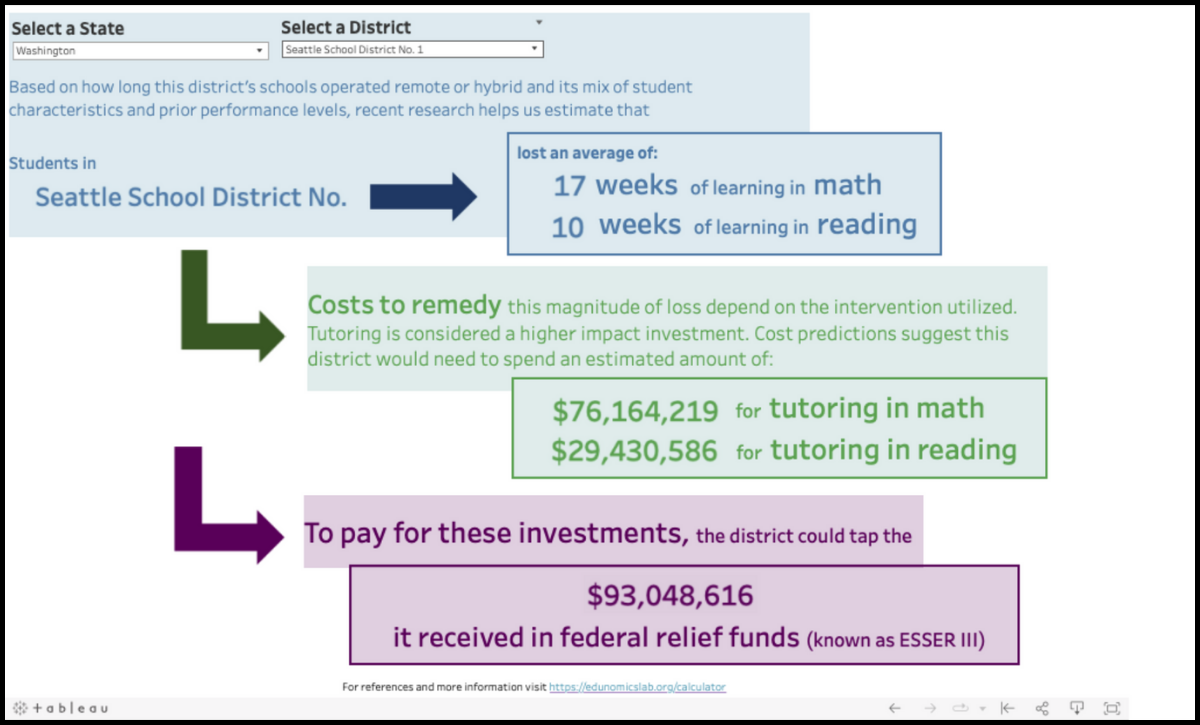New Learning Loss Calculator Estimates COVID Slide, Costs of Catching Kids Up, in 8,000 School Districts
We now know that closing schools in response to the COVID-19 pandemic harmed students academically. So just how much help will they need?

Back when districts wrote their ESSER plans, most didn’t have the information we have today. Many didn’t know yet how different types of students fared with remote or hybrid learning and thus crafting plans to remedy those losses was a struggle.
But new studies are filling in the holes. We now know that closing schools in response to the COVID-19 pandemic harmed students academically. A recent paper for the National Bureau of Economic Research (NBER) demonstrates that the longer the schools stayed closed or operated in a hybrid model the bigger the losses, especially for Black and Hispanic students, those in poverty, or those who were behind grade level to start with.
It may be obvious, but disadvantaged students who learned less will need more help going forward.
So just how much help will students need? We used the results from the NBER paper to build a new calculator tool that estimates the learning losses in more than 8,000 school districts across the country. We plugged in student demographic information and data on the mode of instruction from the American Enterprise Institute’s Return to Learn Tracker. District leaders can use “The Calculator” to estimate the level of student learning loss in their schools.
For example, Seattle Public Schools was fully remote for three-quarters of the 2020-21 school year. Given the makeup of its student body, the available research would estimate that the average district student lost an average of 17 weeks of learning in math and 10 weeks in reading. Some lost more; some lost less.
Our calculator also compares the estimated learning losses with how much money a district would need to spend to remedy them. We used available research on the effect sizes of tutoring (a high-impact investment) to estimate those costs. Based on our calculations, Seattle leaders would need to invest approximately $105 million to address the learning losses in their community.
Fortunately, Congress has provided school districts with three rounds of federal relief funds totaling $190 billion. In the last round, Congress directed districts to spend at least 20 percent of their funds to address student learning loss. In Seattle, the third round of relief funds totaled $93 million; that’s money the district can use to help get students back on track—if spent effectively.
In general, the highest-poverty districts suffered the largest learning losses, but they also received the most money from the federal government. Detroit students, for example, lost an estimated 17 weeks of learning, but the district received more than $800 million in the last round of federal funds.
Wealthier communities received less in federal support, so they may have to dip into their own funds to address the academic losses in their schools, especially if their schools were closed longer. For example, Fairfax, Virginia, is one of the wealthiest counties in the country. But the district kept its schools closed for half a year, and its students suffered losses equivalent to 16 weeks of learning in math and 11 weeks in reading. To make up for that, we estimate the district will need to invest approximately $343 million, substantially more than it received in federal relief funds.
Our estimates are projections based on large-scale analysis and effect sizes from prior years, which amount to just that—a best available guess in the absence of actual data on each district’s students. Districts should be monitoring their own data in real-time to see if students are making progress. The state of Tennessee, for example, released results earlier this month sharing the progress that their students were making, likely in response to the investments made there in tutoring and other supports. Meanwhile, places like Chicago and Newark are still seeing very large declines in student performance compared to where students were pre-pandemic.
We should all care that school districts help students recover the learning time they lost. The research on past educational disruptions suggests that short-term interruptions to schooling can have long-lasting effects on kids. Even 1-3 months of learning losses can interrupt future learning, graduation rates, and persistence in college and careers. We know these gaps will have permanent impacts on students’ lifetime earnings. One estimate pegged the scale of the losses at $2 trillion. Still other studies have connected missed learning time to increased rates of physical disability and a greater reliance on government welfare.
Schools don’t have much time to fix these holes. Students are getting older. For those who are academically behind previous generations, district leaders need to invest wisely to address these gaps in learning. Our concerns are that some districts aren’t yet tackling these losses in ways that meet the magnitude of the problem. In Los Angeles, for instance, the district has negotiated 4 optional school days as a remedy for what the calculator computes as losses of 22 weeks in math and 18 weeks in reading. That won’t cut it.
The good news? Most districts still have plenty of relief funds left to spend. Rather than wasting time rehashing the school reopening debate, we need district leaders to take stock of where their students are, and invest their dollars now in ways that work for students to recover those math and reading losses.
Get stories like these delivered straight to your inbox. Sign up for The 74 Newsletter

;)



